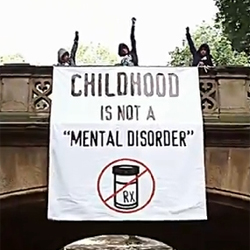By Kelly Patricia O’Meara
November 25, 2013
Recently published research in the British Medical Journal says doctors are concerned that children may be receiving an inappropriate diagnosis of ADHD. Great. It only took nearly six-and-a-half million American children being diagnosed with the alleged mental disorder before doctors finally are questioning whether ADHD is over-diagnosed.
Well, better late than never. And, credit should be given to the researchers for at least acknowledging the massive increase in diagnosing ADHD, and also that they, more or less, blamed the ever-broadening diagnostic criteria for the increase in the alleged brain disorder.
Given what the alleged ADHD has become since its unveiling in the Diagnostic and Statistical Manual of Mental Disorders (DSM-II) of the American Psychiatric Association (APA), published in 1968, one could hardly argue with these researchers. It only took another forty-odd years before the deep-thinkers at the APA figured out how to truly exploit natural childhood behavior.
For example, ADHD was first called Hyperkinetic Reaction of Childhood (or Adolescence) in the DSM-II. What is known today as ADHD was then characterized by “over-activity, restlessness, distractibility, and short attention span.” At that time, the APA explained that “the behavior usually diminishes in adolescence.”
Sounds about right. In fact, who wouldn’t like to have a dime for every time a parent, teacher or any adult, told them to “pay attention,” “listen,” and “sit still.” Of course, anyone with the brain capacity larger than that of a minnow is shaking their head in agreement.
Nevertheless, fast-forward forty-five years and Hyperkinetic Reaction of Childhood (or Adolescence) has become the alleged ADHD. The completely subjective alleged brain disorder no longer “diminishes in adolescence.” Rather, the ever-eager-to-label-what-is-abnormal-behavior-APA has decided that the alleged brain disorder, ADHD, now can be diagnosed in adults.
 The metamorphosis of the alleged childhood brain disorder is extraordinary. For example, the DSM-II dedicated exactly two paragraphs—about 1/6th of a page—to the alleged childhood brain disorder. Since then as many as eight pages of psycho-babble nonsense has been added to describe the subjective “criteria” for the ADHD diagnosis, including subcategories like “Predominately inattentive presentation,” “Predominantly hyperactive/impulsive presentation,” and “Combined presentation.”
The metamorphosis of the alleged childhood brain disorder is extraordinary. For example, the DSM-II dedicated exactly two paragraphs—about 1/6th of a page—to the alleged childhood brain disorder. Since then as many as eight pages of psycho-babble nonsense has been added to describe the subjective “criteria” for the ADHD diagnosis, including subcategories like “Predominately inattentive presentation,” “Predominantly hyperactive/impulsive presentation,” and “Combined presentation.”
What is laughable about the expanded criteria is that there is absolutely zero science to support the diagnosis. In forty-five years, the APA still cannot claim that the ADD/ADHD diagnosis is based in science—a disease of the brain. The best the APA is capable of is adding to the list of subjective criteria that make up the diagnosis.
For instance, “often fails to give close attention to details or makes careless mistakes in schoolwork, work, or during other activities,” “often does not seem to listen when spoken to directly,” and “often has difficulty sustaining attention in tasks or play activities” are just a few of the “abnormal” behaviors that make up the ADHD criteria.
As stated by Harvard psychiatrist Dr. Stefan Kruszewski, “Virtually anyone at any given time can meet the criteria for bipolar disorder or ADHD. Anyone. And the problem is everyone diagnosed with even one of these ‘illnesses’ triggers the pill dispenser.”
Kruszewski is absolutely right. Each child diagnosed with the subjective label of ADHD is that more often than not prescribed mind-altering drugs, which the researchers in the study warned could lead to “unnecessary and possibly harmful treatment.”
ADHD drugs like methylphenidate (Ritalin and Concerta) and amphetamine (Adderall) are referred to as “kiddie cocaine” and listed by the Drug Enforcement Administration (DEA) as Schedule II drugs—the most addictive—along with morphine, opium, cocaine and the heroin substitute methadone.
The DEA also warns that “neither animals nor humans can tell the difference between cocaine, amphetamine, methamphetamine or methylphenidate” and methylphenidate produces “effects nearly identical to cocaine.”
In fact, there have been 31 warnings from eight countries (United States, United Kingdom, Canada, Japan, Australia, New Zealand, France and Singapore) warning that ADHD drugs/stimulants cause harmful side effects. These include:
- 12 warnings on stimulants causing heart problems
- 8 warnings on stimulants causing mania/psychosis
- 8 warnings on stimulants causing death
- 3 warnings on stimulants causing hallucinations
- 2 warnings on stimulants causing depression
- 2 warnings on stimulants causing violence, hostility or aggression
- 2 warnings on stimulants causing seizures
- 1 warning on stimulants causing suicide risk/attempts
- 1 warning on stimulants causing anxiety
Unbelievably, according to the Centers for Disease Control and Prevention, CDC, 6.4 million children in the U.S. (4-17 year olds) received an ADHD diagnosis and seven out of 10 of those children were taking some form of medication as “treatment.” With these disturbing data is it any wonder that doctors finally are concerned about the over-diagnosing of the alleged ADHD?
—
Kelly Patricia O’Meara is an award-winning former investigative reporter for the Washington Times, Insight Magazine, penning dozens of articles exposing the fraud of psychiatric diagnosis and the dangers of the psychiatric drugs – including her ground-breaking 1999 cover story, Guns & Doses, exposing the link between psychiatric drugs and acts of senseless violence. She is also the author of the highly acclaimed book, Psyched Out: How Psychiatry Sells Mental Illness and Pushes Pills that Kill. Prior to working as an investigative journalist, O’Meara spent sixteen years on Capitol Hill as a congressional staffer to four Members of Congress. She holds a B.S. in Political Science from the University of Maryland.


